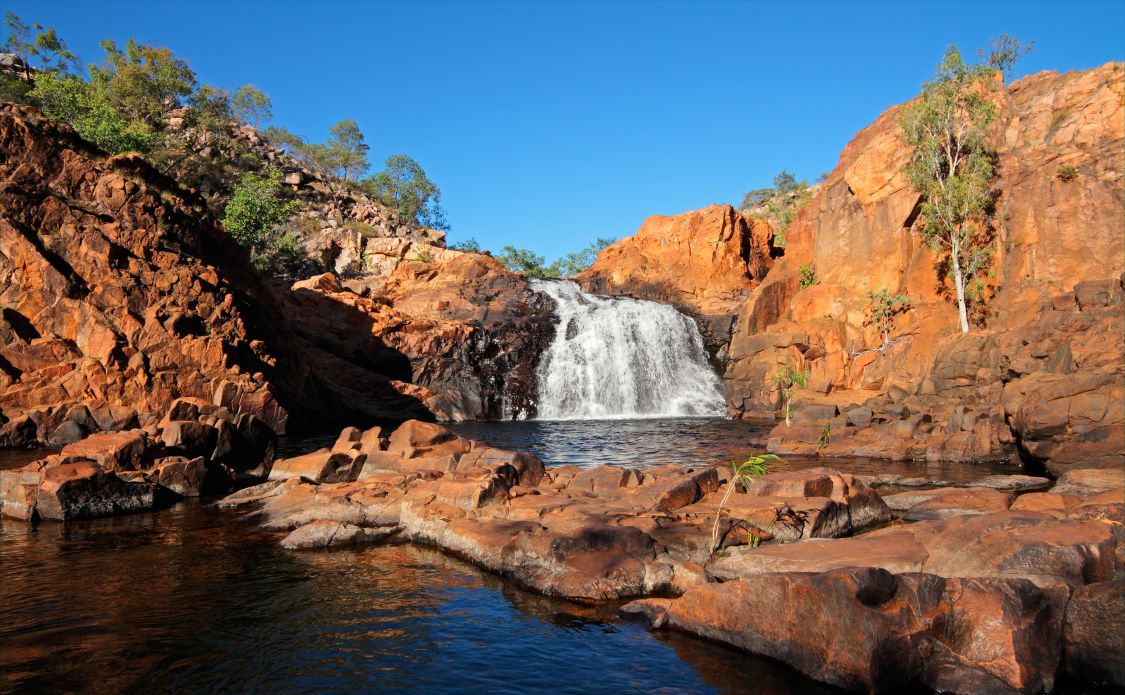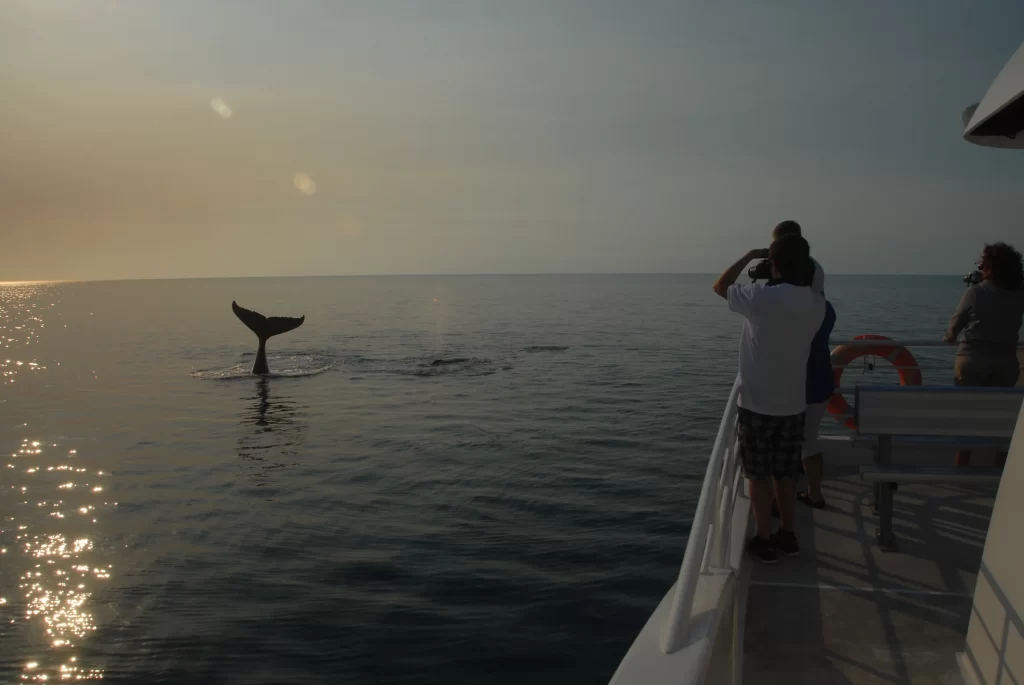Are you considering visiting Australia in Winter? Finding a bit of sun in Australia in June, July and August is possible. The best winter destinations will see you heading to the northern Territory, Queensland and northern NSW, or Western Australia. I love nothing more than escaping the cold in my hometown of Sydney in the winter so below, with a bit of help from some friends I share 16 top spots for a winter holiday in Australia.
This page contains affiliate links. Our full disclosure policy is here.
Kakadu National Park
The Northern Territory is the perfect escape from the cold weather in southern Australia. And the crown jewel in the NT? Well, Kakadu National Park of course! At 19,816 km² this huge national park has a tropical climate, meaning that the “winter” is actually the dry season.
The dry season is the best time to visit Kakadu National Park because this is when most of the attractions are open, including waterfalls and access roads.
During the wet season, many roads within Kakadu National Park are flooded and many waterfalls and swimming holes are closed because of flooding and possibly crocodiles.
The dry season runs from May to October. The weather during the dry season is still warm (around 28 degrees Celsius during the day) with no rain.
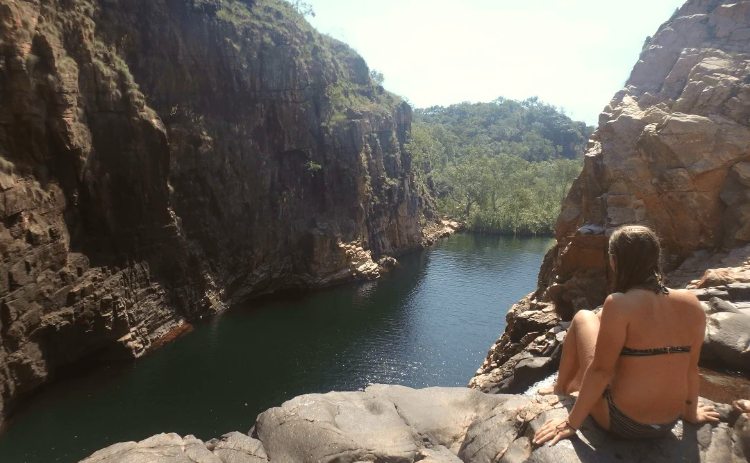
There are plenty of fun things to do in Kakadu. The most popular include exploring different waterfalls – there are tons! Some highlights include Gunlom Falls, Jim Jim Falls, and Maguk. At these falls, you can swim! You can also go on a cruise and see crocodiles as well as other wildlife. Be sure to check out Ubirr and hike to the lookout and see the Aboriginal rock art.
Kakadu is very large, and getting around the park takes a lot of time, 3-days is a minimum amount of time that’s recommended to explore Kakadu, the more time you have, the better!
Kakadu National Park is most commonly visited when in Darwin. This is because it is less than a two hour drive from Darwin. You can either drive yourself to Kakadu and explore on your own or join one of the many Kakadu tours from Darwin.
By Bailey from Destinationless Travel
See our guide to the best times to visit the Northern Territory for best weather and local festivals.
Darwin
Of all Australian destinations, Darwin in the Northern Territory would have to be the perfect place to visit during an Australian winter. Some of Darwin’s famous attractions are seasonal and only operate during the dry season between May and October when the tropical weather cools to a balmy 22 to 32 degrees Celsius.
From the end of April to October, set aside Thursdays and Sundays from 4pm to 9pm to visit the vibrant Mindil Beach Sunset Markets for a colourful mix of stalls that sell a selection of artisan products and highlight Darwin’s multicultural food scene.
Learn about the day that World War II came to Australian shores with the bombing of Darwin in 1942 at the Darwin Military Museum. Get up close and personal with a saltwater crocodile on a visit to Crocosaurus Cove.
Cool off in the Wave lagoon at the Darwin Waterfront Precinct or relax with a Darwin sunset at one of the historic Stokes Hill Wharf eateries.

Outside of Darwin you can visit the moving Adelaide River War Cemetery, take a Jumping Crocodile Cruise from Adelaide River or discover the wildlife and bird life of the Mary River Wetlands on a Mary River Wetlands Cruise.
A little further afield, get a taste of the real Northern Territory and head to the ancient landscapes of the Kakadu and Litchfield National Park.
There is so much more to see and do in Darwin and to get the most out of the region, stay at least a week. There are lots of day trips to do from Darwin to help you see more of the territory.
By Ros Cuthbertson of Frequent Traveller
Litchfield National Park
Litchfield National Park is also in the Northern Territory, about a 2-hour drive south of Darwin. It’s visited by over 300 thousand tourists each year for swimming or hiking and is one of the most popular places in the Top End. This area is a great day trip from Darwin, or stay a few nights and enjoy all the park can offer.
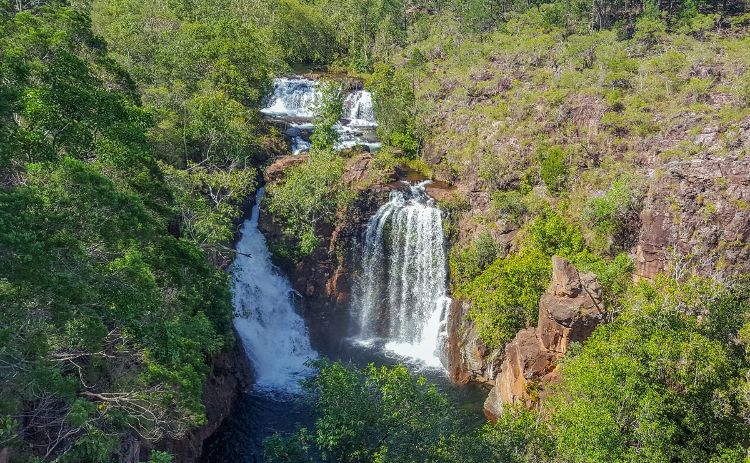
The year-round summer temperatures in the north make the park’s several swimming spots must see locations.
These include the stunning Florence Falls, which have a 30 metre drop and a refreshing waterhole below. The hike is only 430 metres to the bottom, but does involve walking downstairs. Obviously, this is fairly easy on the way down, but a bit of a heart starter on the way back up.
Alternatively, you can give the Buley Rock Hole a try with its cascading pools, Wangi Falls for easy access, and the Tourist Information Centre.
Apart from that, you have very unusual and tall magnetic termite mounds. They have an extensive system of tunnels for the termites, climate-controlled and built with its main axis running north to south. Interesting enough, the termites saliva is used to build these marvels, which increases weatherproofing and makes them resistant to rain erosion. The sheer size will amaze you.
If you are looking to stay near the area, then there are basic (unpowered) camping facilities in the national park. Otherwise, you can stay in nearby smaller towns like Batchelor, which offer motels and Caravan Parks.
Chris Fry, The Aquarius Traveller
Uluru
Uluru/Ayers Rock, Australia’s most recognisable natural landmark, is a popular winter destination. Compared to the sizzling summer temperatures that can exceed 35 degrees, winter weather boasts comfortable daily highs of 20 degrees, making it more comfortable, and safer, to walk or cycle around Uluru.
Another advantage is that August and September visit to Uluru are usually the best months to see the national park’s wildflowers in bloom.
While admiring the stunning monolith from viewing platforms during sunrise and sunset are must-do activities, getting up close and personal with Uluru is highly recommended. Uluru has a circumference of 9.4 kilometres, so a leisurely half-day base walk allows visitors to admire its diversity, including a rich green belt, rock pools, rock drawings, and how the forces of nature have shaped Uluru’s surface.

Cycling around Uluru is another, perhaps better, option, with cyclists and hikers travelling in opposite directions. From the bike rental station near the Uluru-Kata Tjuta Cultural Centre, the 15-kilometre bike ride takes about three hours, including plenty of stops to read the many information boards, take photographs, and appreciate the beauty of this magnificent landmark.
While experiencing the splendour of Uluru is the main draw, there’s so much more to do within Uluru-Kata Tjuta National Park and the surrounding region.
The closest accommodation to Uluru is at Yulara, 18 kilometres from Uluru, where a host of activities and educational presentations and performances are organised for guests. Spending at least three days allows visitors to experience these, and other, highlights of the area.
Suggested by Anne from Packing Light Travel
The Larapinta Trail in Central Australia
You may find it hard to be active in winter, so a warm desert hike to get the blood flowing may just be exactly what you need!
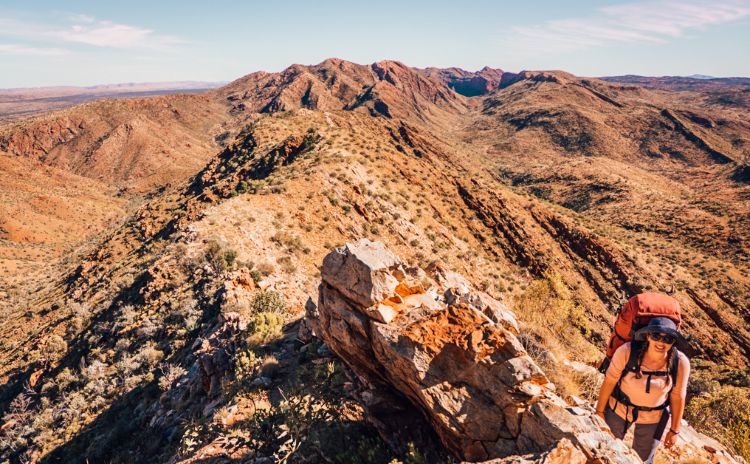
The Larapinta walk is a 223km trail that traverses the arid red rock ranges of the West MacDonnell National Park near Alice Springs in Central Australia. The trail was voted by National Geographic as one of the top 20 trekking experiences on the planet and it’s easily one of the best walks in Australia.
It’s divided into 12 trailheads, meaning you can hike all 12 sections over 12+ days, or pick your favourites and only hike for a day or two. It’s completely up to you!
Sleep under the stars, swim in isolated waterholes (even in winter), marvel at spectacular views and rock formations as far as the eye can see, and challenge yourself on this world-class hike.
You can walk the Larapinta Trail between May and September, but the best temperatures for hiking is during the winter months from June to August. Winter will usually give you gorgeous, crisp, clear days of around 20ᵒC and with night temperatures dropping to around 0ᵒC, so bring a warm sleeping bag.
Want to know more about planning this multi-day experience? Read the full article on doing a self-guided Larapinta Trail hike for all you need to know about this incredible Australian destination.
Crystal from Castaway with Crystal.
Broome
On the northwestern coastline of Australia and the gateway to the magnificent Kimberley region, by far the best time of the year to visit Broome is during the Australian winter. Once the rains and cyclones of summer have gone, winter sees endless days of sunshine and beach weather.
Despite being about as far as you can get from anywhere else in Australia, Broome is also surprisingly easy to reach. Thanks to direct flights from many cities around Australia, it’s just a few hours’ flight rather than a multiple day drive. Which opens the possibility of just a quick trip, rather than a long sojourn.
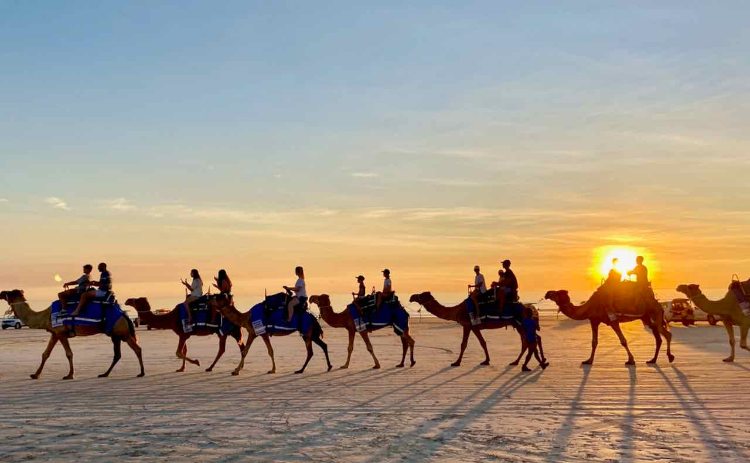
Top of the list of what to see in Broome is Cable Beach. This 22km long stretch of white sand is enormous at high tide. Hire a beach chair or bring your own towel to the main swimming area, or hire a 4WD to drive along the beach and find your own private stretch of sand. Just beware that clothing is optional once you leave the town behind…
Come sunset, it’s a must to set up a chair on the beach and watch the sun set into the Indian Ocean, drink in hand. That’s if you’re not riding a camel along the beach.
Camel rides were introduced to Cable Beach decades ago and are still very popular, especially at sunset. Make sure you book well in advance.
If you can prise yourself away from Cable Beach, there’s plenty more to do in Broome. Look for dinosaur footprints at Gantheaume Point, catch a flick at the historic Sun Pictures, enjoy a mango beer at Matso’s, visit the weekend Courthouse Markets or time your visit for the monthly Staircase to the Moon. An overnight trip north to the Dampier Peninsula is also a fascinating excursion.
Shandos Cleaver from Travelnuity
Exmouth
Exmouth on Western Australia’s Coral Coast is the perfect place to visit in Australia in Winter. Not only do you get lovely daytime temperatures in the mid to high 20s, but it is also the best time to see Exmouth’s feature attraction – Ningaloo Reef. Ningaloo is a fringing reef which means you can access it right from the beach. Just metres from shore you will be snorkelling with tropical fish, turtles, rays and (friendly) reef sharks.

There are several sites along the coast where you can get onto the reef. Turquoise Bay and the Oyster Stacks are popular. Winter is also when migratory whale sharks arrive on Ningaloo Reef. Swimming with whale sharks is on every nature lover’s bucket list. There are also tours to see turtles and swim with humpback whales.
On land, you can drive, hike and cruise your way around Cape Range National Park. Winter is the best time to explore the red rock gorges and wildflowers. The boat cruise along Yardie Creek gives you a great view of one of the canyons. Charles Knife Canyon and Thomas Carter Lookout both offer great views of the range that runs parallel to the reef.
Exmouth is 1200 kms from Perth. If you drive, allow a week or more for stops along the way like Kalbarri and Shark Bay. In Exmouth, allow 5 days to see the reef, range and town. You can fly to Exmouth (arriving at nearby Learmonth), but you will need a car to get around. If you plan to spend a lot of time in the water, you’ll do less driving if you stay on the reef side of the Exmouth Peninsula. The Yardie Homestead Caravan Park is a good option, there are also beach campsites available through WA National Parks.
Steve from The Curious Campers
Shark Bay
The Shark Bay World Heritage Area is located around 800km north of Perth, at the most western point of the state. The bountiful wildlife and unique landscapes combine to offer this place a magical quality.
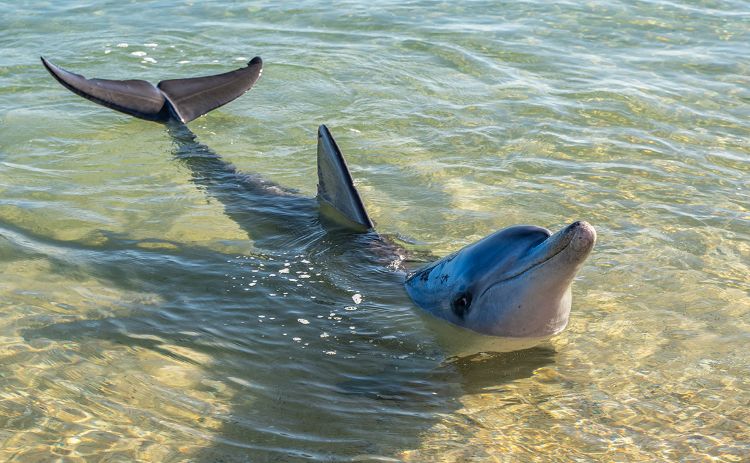
Imagine starting your day with a short stroll to the beach where you can come face to face with wild dolphins. Each morning the wildlife rangers feed the dolphins a small amount of fish, which keeps them coming year round but doesn’t interrupt their natural hunting patterns.
The other big draw-card here are the picturesque burnt orange dunes, contrasted against striking turquoise water. The Francois Peron National Park offers fantastic 4WDing adventures and has become a hot-spot for photographers.
You can’t leave this area without seeing the incredible animals it is named for. At Ocean Park Aquarium, you can get up close and personal with sharks and other local sea creatures. The shark feeding times are a real highlight.
If escaping into the wilderness is more your vibe, then head out to Dirk Hartog Island. This isolated area is a haven for wildlife and a boat trip around the coast is a must, even if you set foot on the island itself.
Shark Bay is the perfect winter escape from Perth and a must-see stop on a longer road trip to Exmouth and beyond. The winter months have temperatures in the 20s and only 4 days of average rainfall!
You should plan for 5 days to explore everything, but if rushed, you can see the major highlights in three days.
Rick from The Road Is Life
Coober Pedy
Lying 846 km north of Adelaide, Coober Pedy is one of Australia’s most curious Outback towns, famous for its underground lifestyle. With the ground temperatures reaching up to 50 degrees centigrade in summer, most of the town’s service buildings are located underground.
There are underground apartments, shops and hotels, an underground church, and even an underground caravan park! Visiting Coober Pedy in winter lets you explore all the town’s curiosities while enjoying the mild temperatures in the mid-20s.
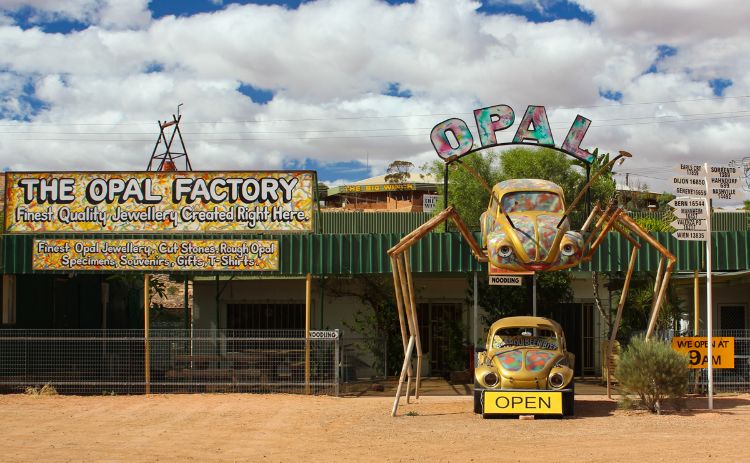
There are enough things to do in Coober Pedy to fill a couple of days of exploring, or you can use the town as an overnight base on your Outback road trip.
While you are in the area consider visiting Wilpena Pound
While in town, make sure to visit the underground church and the bookshop; check out Riddick’s spaceship from the set of Pitch Black – it’s now parked in the town centre; visit the opal fields or try your hand at digging for opals. After all, Coober Pedy is considered to be the opal capital of the world.

One of the most striking natural formations near Coober Pedy is the Kanku-Breakaways Conservation Park, just 33 km out of town. The stark landscape of the Breakaways is made up of a series of multi-coloured eroded hills rising over a desolate rocky plane that looks just like the surface of Mars. Don’t leave the Breakaways without checking out the famous Dingo fence – a 5,614 km-long construction built in the late 1800s to exclude dingoes from the sheep country in south-eastern Australia.
From Margarita, The Wildlife Diaries
Palm Cove
Palm Cove is the perfect destination for travel in Australia in winter. With temperatures ranging from a minimum of 17 degrees to 27 degrees, you can shake off those winter chills from the southern states with ease.

Palm Cove is located 30 minutes from Cairns Airport, which is serviced by the 3 major carriers Qantas, Virgin and Jetstar from all over Australia.
Car rental is recommended. There are the major car rental companies available onsite at Cairns Airport as well as several smaller companies offsite. Having a car at your disposable will give you the opportunity to enjoy the top things to do in Palm Cove and visit the surrounding hinterland, Port Douglas, Cairns and more.
With the Great Barrier Reef on your doorstep, there are many opportunities to enjoy the best of cruises out to the Reef visiting two of the popular islands–Fitzroy and Green Island.
If time permits, head north for a day trip enjoying Mossman Gorge, Daintree Rainforest and Cape Tribulation.
Palm Cove is a haven for foodies. You will need to make reservations in advance for the well-renowned award-winning restaurant NuNu with its exotic tropical setting and innovative locally sourced produce menu.
Several other restaurants to consider are Vivo and the Greek restaurant El Greko, both on Palm’s Cove beachfront Esplanade.
A fun thing to do at sunset is to enjoy a picnic with the best fish and chips from Lucky Fish. Grab a bottle of chilled Australian wine and head to the beachfront opposite Lucky Fish on the Esplanade and enjoy the setting sun in the warmth of the night.
How much time do you need to spend in Palm Cove? At least 7 nights is highly recommended, more if you can. Enjoy your tropical winter escape!
By Jane from Staycation Australia
Check out our guide on where to stay in and around Palm Cove
Cobbold Gorge
Cobbold Gorge is an erosion-formed slot canyon on a privately owned cattle farm in North Queensland. It was discovered in the 1990s, and the property owners have been running tours to visit ever since. It’s easy to see Cobbold Gorge on a day trip or stay longer to appreciate the facilities available. Due to heat and rain, the tourist season runs from April to October each year and why it’s a perfect place to visit during winter in Australia.
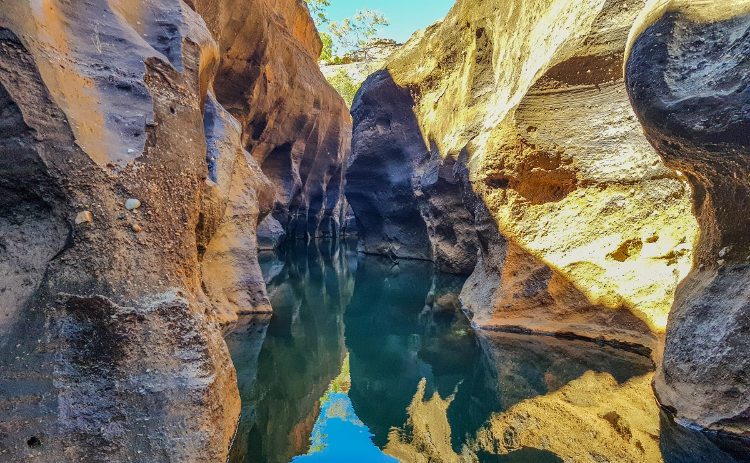
The only way to see the stunning Cobbold Gorge is by booking a tour, there are several options. The popular boat tours require three hours to meander down the gorge and return the same way. In 2019, the boat tour was extended further with a new addition of a 13 metre glass bridge walkway. This provides an overall look up each end of the gorge, as well as the added thrill of seeing a 19 metre drop below.
For those after a different adventure, paddle boarding tours can be experienced in the early morning and late afternoon when the gorge is shaded. Paddle at your own pace while listening to the echoing sounds around the gorge.
Lastly, helicopters are needed throughout the year for cattle driving. Therefore, they also provide an aerial view of Cobbold Gorge & the glass bridge during the tourist season.
If you’re staying for longer, you can take advantage of using the Infinity pool, restaurant, bar, or spend your evenings by the campfire with a couple of drinks. Either way, on most nights you’ll see the bright colours light the sky up with an unbelievable, outback sunset.
Chris Fry, the Aquarius Traveller
Whitsunday Islands
A group of 74 Islands off the coast of Northern Queensland, the Whitsundays, are an incredible place to get lost and explore nature. Throughout the island chain, you’ll find beautiful coral reefs and the reefs and islands stretch all the way to the Great Barrier Reef.

The Island chain is known for its beautiful beaches, some of which with such fine sand you could exfoliate your skin. The only way to visit the islands is by boat, and the best way is aboard a liveaboard boat. Most boats to the islands leave from nearby Airlie beach, and there is ample opportunity to join a tour or charter a boat for any number of days.
The vast majority of the islands are uninhabited and there is an opportunity for camping in the various islands of the national park. For those who don’t want to rough it, there are a few options for lodging on several of the islands.
The most popular things to do in the Whitsundays include beach-going, sunbathing, snorkeling, and scuba diving. The water is warm all year round and the oceans are teeming with life. You’ll step into the water and find fish approaching to investigate you.
Australia’s winter is the prime time to visit the Whitsundays. Winter is the dry season in the area, and the less frequent rains improve the visit to the islands. First, Australia winter is out of season for the jellyfish, so you won’t need to wear lycra suits while in the water. Additionally, the lack of rain improves visibility for snorkeling and scuba diving so you’ll have impressive sight of the coral and wildlife in the area.
Contributed by Anwar from Beyond my Door
Hervey Bay
Winter in Hervey Bay brings sunny skies and daytime temperatures averaging around 22°C. It’s the perfect time to enjoy the attractions and relaxed vibe of the Fraser Coast. There are plenty of things to do in Hervey Bay all year round but during winter it is especially popular.

The big show in town between July and November is the arrival of the southern humpback whales. They make their annual migration from Antarctica to the Great Barrier Reef, stopping off in the shelter of Fraser Island (K’gari) to spend time in the bay.
While the migration is a time of constant motion, long distances and fast travel, Hervey Bay is special because many of the whales stop in the bay for a few days at a time.
In the calm waters, they are relaxed and playful, regularly interacting with the boats. They spy hop to get a better look at those on board, swim under and close alongside the boats. They have even been known to come right in to the heritage Urangan Pier.
It’s easy to view a full spectrum of whale behaviours out on the water. There are the dramatic body slams of courting behaviour, the curious juveniles checking out everything on their first migration and the current year’s baby whales, born in the tropical waters, now learning all the essential skills they will need for the long trip home.
There are a variety of operators running large and small group boat trips out of the Great Sandy Straits Marina. It’s usually only around 20 minutes until you are out with the whales and the boats stay within the calmer waters of the bay rather than out in the open water.
Hervey Bay is well set up for visitors with a good range of hotels and self-contained accommodation, local restaurants and cafes. This sunset cruise is a lovely way to end your visit.
Contributed by Toni Broome from 2 Aussie Travellers
Coolum Beach
Looking for winter sun in Australia? Then follow the humpback whales to the warmer waters of Coolum Beach on the Sunshine Coast of Queensland. Coolum is a small but busy coastal village perfectly situated some 20 minutes south of Noosa and 40 minutes, both north of Caloundra and east of the quaint mountain village of Montville.
Importantly, it is an easy 1 hr 40 minutes’ drive north of Brisbane Airport. Shuttles connect airport to Coast.

If you can imagine yourself beach walking, swimming or surfing daily, then Coolum is the place for you.
Coolum has spas for pampering, barefoot bowls for fun or climbing Mount Coolum for a heart-pumping workout. It is about BBQ’s and picnics in the park and a happy casual experience. Children love the beachfront skate-park, playground and big tree to climb.
Shoppers will adore nearby Eumundi Markets and located right in Coolum itself are the twice-monthly Salty Saturdays afternoon/night food market and Sunday Sunshine Coast Collective Markets.
Coolum Surf Club has panoramic ocean views, a protected deck and glass fronted dining rooms. Try a locally brewed beer or an award-winning wood fire grilled steak. Booking is recommended.
The best thing about holidaying in Coolum is how easy it all is. Boutiques, surf shops, cafes, restaurants, pub, Surf Club and Caravan Park cosy together on the beachside strip. Coles and Dan Murphy’s Store are walkable from the beach with Woolworths just a few minutes away by car.
Accommodation in Coolum Beach is sprinkled north and south opposite the coast and a few streets back, with many choices having great views and/or swimming pools.
Families spend weeks at Coolum during September or December School Holidays, while couples enjoy anything from a sneaky weekend getaway to a lengthy wind down and chill out.
Contributed by Jan from Budget Travel Talk
Discover more beaches on the Sunshine Coast
Atherton Tablelands, Queensland
Atherton Tablelands is the perfect place to escape the Australian winter and is just a 60 minute drive from Cairns along the Kennedy Highway. The weather in winter is very mild, with average daytime temperatures in the low 20 degrees celsius making it perfect for exploring all the hidden gems this region has to offer.
There are lots of things to see and do in Atherton Tablelands including breathtaking viewpoints, beautiful waterfalls, cerulean blue lakes, and lush tropical rainforest.
The Tablelands is a region strewn with clusters of townships, each with something interesting to offer visitors. The town of Atherton was the first town settled in the region, and here you will discover the history of the Chinese immigrants in the area dating back to the 1800s. People who love coffee and vineyards will take pleasure in Mareeba and its surrounding areas.

Undoubtedly worth a visit if you’re journeying through Atherton Tablelands, the historic town of Yungaburra is among the most beautiful attractions in Far North Queensland, and considered by many to be the most beautiful town in the region.
A number of the noteworthy sights that can be discovered in and around town, or within a short driving distance include the Yungaburra Heritage Trail, the Peterson Creek Walking Track where you may be lucky enough to spot a platypus, Curtain Fig Tree, Lake Eacham and Lake Barrine.
Another interesting place to visit is the historic town of Herberton, an old mining town nestled into the hills. A visit to the Historic Village Herberton, an open-air museum showcasing Australian pioneering history, is a must.
From there, spend some time exploring the 17 kilometre Millaa Millaa Waterfall Circuit nestled amongst the rainforest-clad Wooroonooran National Park.
Allow 4 days to 2 weeks to explore the region of Atherton Tablelands as each and every single town and its surrounds offer endless opportunities.
Yungaburra is a great place to base yourself exploring this region, however, you will encounter lots of accommodation options no matter your travel style or budget.
Recommended by Peta and Jonas of Exit45 Travels
Check out this self-guided tour of the Atherton Tablelands for your next visit
Byron Bay
Beautiful Byron Bay in northern NSW is known for its stunning surf beaches and lush, green surroundings. The town’s laid back surf culture blends easily with a relaxed alternative vibe and a more up market “yuppy” feel. Located close to the Queensland border, Byron Bay has a mild climate year round and this makes it an ideal winter destination in Australia.

One of the town’s most important landmarks is the Lighthouse on Cape Byron at Australia’s most eastern point. It’s an ideal place to look for whales as they pass by close to the coast during the annual whale migration in the winter months from May to November. The views from the lighthouse are spectacular and the coastal walk along the cliff tops to the Cape Byron lighthouse is very popular.
Byron Bay was a meeting place for the local Indigenous tribes, the Bundjalung people and visitors still come from around Australia and the world to enjoy Byron Bay’s many attractions. You can go whale watching, kayak with the dolphins, learn to surf, and take a beach yoga class or join an aboriginal culture tour and discover why Byron Bay is one of the most visited destinations in Australia.
Contributed by Linda from Muy Linda Travels
Got more questions? Head over to our Australian Travel community on Facebook
and we will do our best to help.

